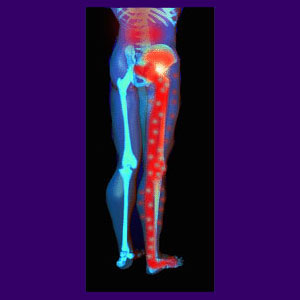
Back pain from Morton’s foot is a possible explanation for symptoms related to over-pronation and its collateral effects on the form and function of the spinal and postural muscle anatomy. Morton’s foot is also commonly diagnosed as Morton’s toe, Morton’s syndrome, royal toe, Greek foot or hallicusbradymetatarsalgia. All it really means is that the second toe is longer than the first.
The typical human foot is designed to bear the majority of weight over the first metatarsal bones, on the inner aspect of the ball of the foot. However, when Morton’s toe is present, the weight of the body tends to reside more over the second and third metatarsal bones on the center of the foot. This change causes the foot to pronate excessively, turning inwards and flattening out the arch of the foot significantly.
This report examines the possible relationship between Morton’s foot and back pain. We will cover both sides of the argument as to whether Morton’s foot is a likely cause of pain or not in order to provide editorial objectivity for contrasting schools of medical thought.
Back Pain from Morton’s Foot Relationship
Morton’s foot is a known contributor to pronation of the feet, as well as possible eventual flat footedness. The mass of the body is meant to be borne over the large toe, with the majority of weight placed on the innermost ball of the foot. In people who demonstrate Morton’s foot, weight tends to reside in the middle of the foot, causing changes in form and function to many other structures in the anatomy. While most doctors agree that these changes are minor and not inherently pathological, other doctors suspect that the pronation of the foot provides enough justification for many painful symptoms to occur.
The idea of back pain being linked to foot abnormalities has long been embraced by podiatrists, some orthopedists and sports medicine practitioners and even some chiropractors. These healthcare professionals have studied the anatomy and realize that changes from the ground up influence the entire form of the body built on top of the feet. In essence, the integrity of the body is only as strong as the basic structure and design of the feet on which it is supported.
Morton’s Foot Back Pain Diagnosis
Diagnosis of Morton’s foot can be achieved from simply visualizing the feet. A trained healthcare provider will also quickly be able to ascertain the extent (if any) of foot pronation associated with the Morton’s toe condition. Some visual clues to this phenomenon include the way the feet interact with the ground, the depth and condition of the arches of the foot and the alignment of the heel bone with the ankle when viewed from the posterior perspective.
Diagnosing back pain from Morton’s foot is more complicated, since various mechanisms of action can link the 2 conditions. Changes in specific muscles or general postural musculature can result from excessive pronation of the foot. Changes to spinal curvature and particularly the lumbar lordosis might also result. Sacroiliac joint changes might be noted, as may hip, knee and ankle degeneration. Existing areas of central spinal and neuroforaminal stenosis might be aggravated by changes in gait and posture. However, these circumstances might not be symptomatic or might be symptomatic and incidental to the excessive foot pronation.
Back Pain from Morton’s Foot Debate
Just as some care providers see definite relationships between Morton’s foot and the existence of various types of back pain, most doctors do not believe the condition to be causative and many even go so far as to say it is not likely to be even the slightest bit contributory to dorsalgia. The human anatomy has been proven to be incredibly adaptable to structural and functional changes. Therefore, the anatomy can naturally compensate for all manner of defects, deficiencies and irregularities. Morton’s toe is such a minor issue that these doctors argue that it could not be a primary source of back pain.
Some care providers even argue that the way the feet develop are the direct consequences of higher level structural conditions, such as upper cervical spinal subluxations, so that Morton’s’ foot and various types of pronation concerns may actually results, rather than causes, of higher level anatomical issues.
We provide full coverage of the relationship between the feet and the back in several other detailed essays that are certainly worth your attention if you are interested in this fascinating topic. Please enjoy our previously mentioned articles on flat footed back pain and pronated foot back pain in order to complete your research on the interplay between the spine and the lowermost appendages.





